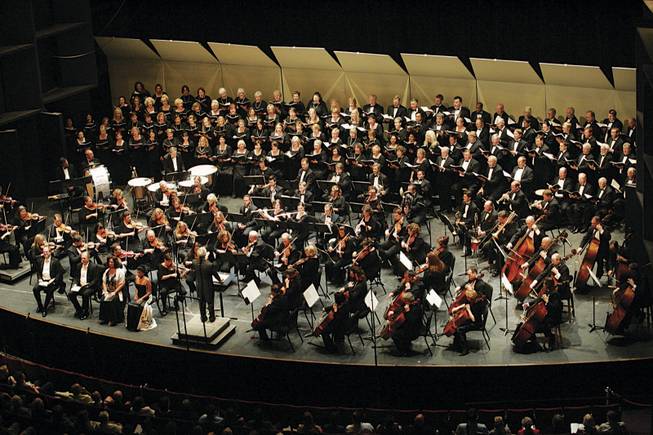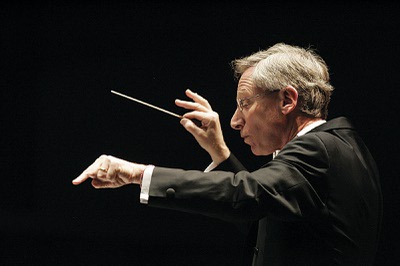
Las Vegas Philharmonic performs Beethoven’s Symphony No. 9 Saturday at UNLV’s Artemus Ham Hall. More than 100 singers joined the orchestra for part of the evening.
Tuesday, May 19, 2009 | 2 a.m.
Beyond the Sun
Las Vegas Philharmonic closed its season on a note of triumph Saturday night, as more than 200 musicians and singers and a capacity crowd filled UNLV’s Artemus Ham Hall for a literally big finale: an admirable rendering of Beethoven’s oceanic Symphony No. 9.
The evening opened with something unusual for this orchestra, a modern piece. “La Creation du Monde,” composed in 1923 by Darius Milhaud, is a jazz-influenced ballet in six parts, inspired by the Parisian composer’s strolls in New York’s Harlem in the 1920s.
Conductor David Itkin arranged a small, asymmetrical configuration of 17 musicians onstage, including alto saxophone, cello and a flutter-tongued flute among the primary voices.
The funny thing about the Milhaud piece, which, Itkin said in his introduction, describes “primordial chaos,” is that it’s kind of hard to tell if the musicians are playing it right. Woozy, bluesy and dissonant, marked by percussive punches of piano and slashes of strings, it sounded in its more melodic moments like Gershwin on downers, and in others like a complex wristwatch coming apart — or, as Itkin put it, “roughly like a Parisian cafe had just exploded all over the street.”
The 20-minute piece left the audience nonplussed. I may be giving music director Itkin too much credit, but programming the Milhaud seemed like the conductor’s punk-rock move, signalling to the audience: “Don’t get too comfortable.” Although the most way-out piece scheduled for the 2009-10 season is Bartok’s Concerto for Orchestra, perhaps he was bracing us for future surprises — can we hope we’ll be hearing more modern or contemporary classical music in coming seasons?
After an intermission, the audience returned to find the stage filled to overflowing with the supersized orchestra for the Beethoven symphony.
Itkin took a balanced and mellifluous approach to the 185-year-old masterwork, not attempting anything daringly dynamic or idiosyncratically show-offy.
The Philharmonic took the first and second movements with impressive confidence and bite. Alternating between chunky and smooth, elegantly cantering and calmly magisterial, the instrumentation was supple sounding, distinctly voiced and crisply articulated.
Before the adagio third movement, more than 100 singers filed solemnly onstage, filling four tiers behind the musicians and spanning the width of the stage. The singers — women in black dresses and pearls, men in black tie — waited at parade rest through the meandering, silkily lyrical movement, which was the only part in which the Philharmonic wavered. The orchestra still seems to do best with music that has a more defined pulse.
This was the clearest example of the benefit of enjoying classical music live versus on CD. It was absorbing to see these so-familiar sounds come to life — and to watch Itkin animatedly bounce and sway, conducting with his body more than his baton. And there was anticipation and actual suspense in watching the four vocal soloists and the massed choirs waiting for Itkin to signal them to rise.
A brief interjection: The Smith Center can’t come soon enough for the Philharmonic. The Beethoven revealed some sonic dead spots in the hall, the aural equivalent of the blind spot in your car. I’ve noticed it before, and unfairly blamed the woodwinds and other instruments in the middle range. On Saturday the acoustics rendered the mezzo-soprano almost inaudible and muted the power of the massed voices.
An unexpected side effect of experiencing the Beethoven: I’m sure I’m not alone in having my curiosity piqued about the choral music groups in the Vegas area. I was impressed by the combined forces of the Las Vegas Master Singers and the Desert Chorale, and plan to seek out future performances by both.
Finally Itkin gave the nod and the elegantly dressed soloists — soprano Veera Khare Asher, mezzo-soprano Juline Barol-Gilmore, tenor Mark Thomsen and baritone Paul Rowe — rose to deliver the intertwining lines voiced earlier by the cellos and basses.
And then the main event, the robust men robustly echoing and volleying with the clarion women in the resounding variations, building to the cathartic, celestial “Ode to Joy,” which evoked a surge of joy — and more than a bit of pride — in our Philharmonic.


Join the Discussion:
Check this out for a full explanation of our conversion to the LiveFyre commenting system and instructions on how to sign up for an account.
Full comments policy